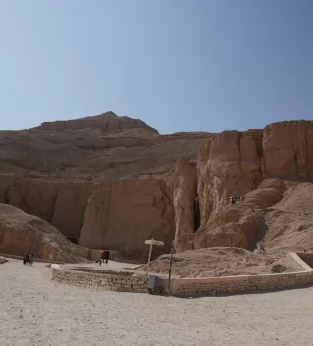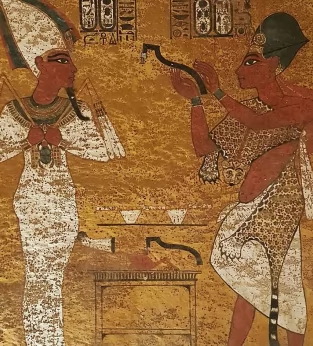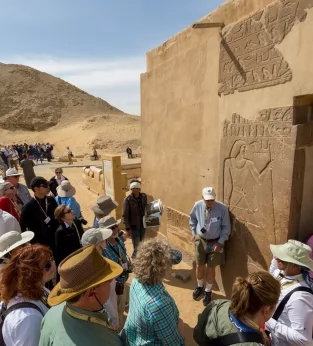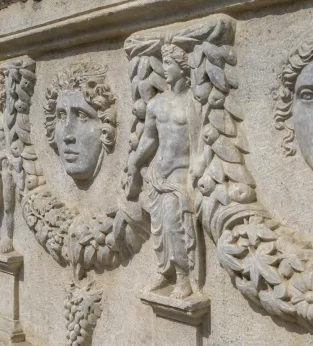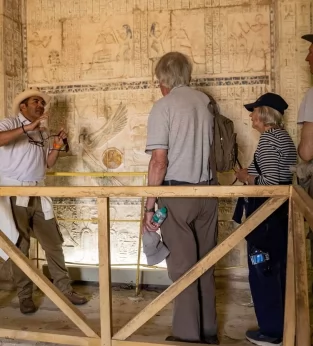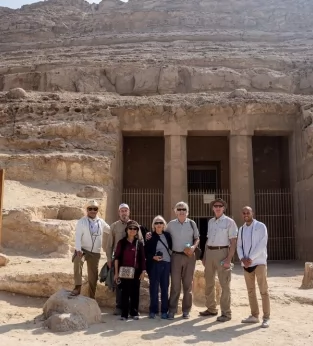Stay updated!
Visiting the Valley of the Queens
The Valley of the Queens in Egypt is an important archaeological site located near Luxor, Egypt, often included in a comprehensive Luxor city tour. This UNESCO World Heritage Site is known for its ancient tombs, which were the final resting places of various queens, princesses, and other members of the royal families from the New Kingdom period of ancient Egypt.
With Inside Egypt you can discover these tombs on our Valley of the Queens tour. The UNESCO World Heritage Site offers a unique opportunity to explore the rich history and culture of ancient Egypt. This tour provides insights into the lives, beliefs, and burial practices of the royal women of the New Kingdom era, allowing visitors to connect with Egypt's fascinating past.
On our tour, you will see well-preserved artwork, including colorful murals, hieroglyphics, and depictions of deities and daily life scenes. These artistic treasures provide valuable glimpses into the religious and artistic practices of ancient Egypt.
One of the most famous attractions of visiting the Valley of the Queens is the Queen Nefertari tomb, the favorite wife of Pharaoh Ramses II. The Queen Nefertari tomb is renowned for its exquisite decorations and detailed artwork, making it one of the most beautiful tombs in Egypt. And you will see this spectacular site on our Valley of the Queens tour.
You will explore the Valley of the Queens in Egypt with our exceptional guide, who will significantly enhance your experience. Our guide is knowledgeable and passionate about the history, mythology, and architecture of the site. He provides valuable insights, answers your questions, and helps you understand the significance of the tombs at the Valley of the Queens and their contents.
Your guide will provide historical and cultural context, helping you understand the broader significance of the Valley of the Queens within the larger context of ancient Egypt. He explains the connections between the tombs, the ruling pharaohs, and the political and religious climate of the time, making your visit more informative and meaningful.
Our guide will help you navigate the Valley of the Queens site efficiently, ensuring that you don't miss any important tombs or highlights. The guide is familiar with the layout, and the best routes. It will help you make the most of your visit to the Valley of the Queens.
Visiting the Valley of the Queens in Luxor with Inside Egypt offers a unique and enriching experience.
A visit to the Valley of the Queens, which includes the option to tour Queen Nefertari's tomb for an additional fee, is part of our 14 Days in Egypt Tour. However, during the 17 Days in Egypt on a Long Nile Cruise and 10-Day Tour of Egypt, you can also include a visit to the Valley of the Queens as an optional tour.
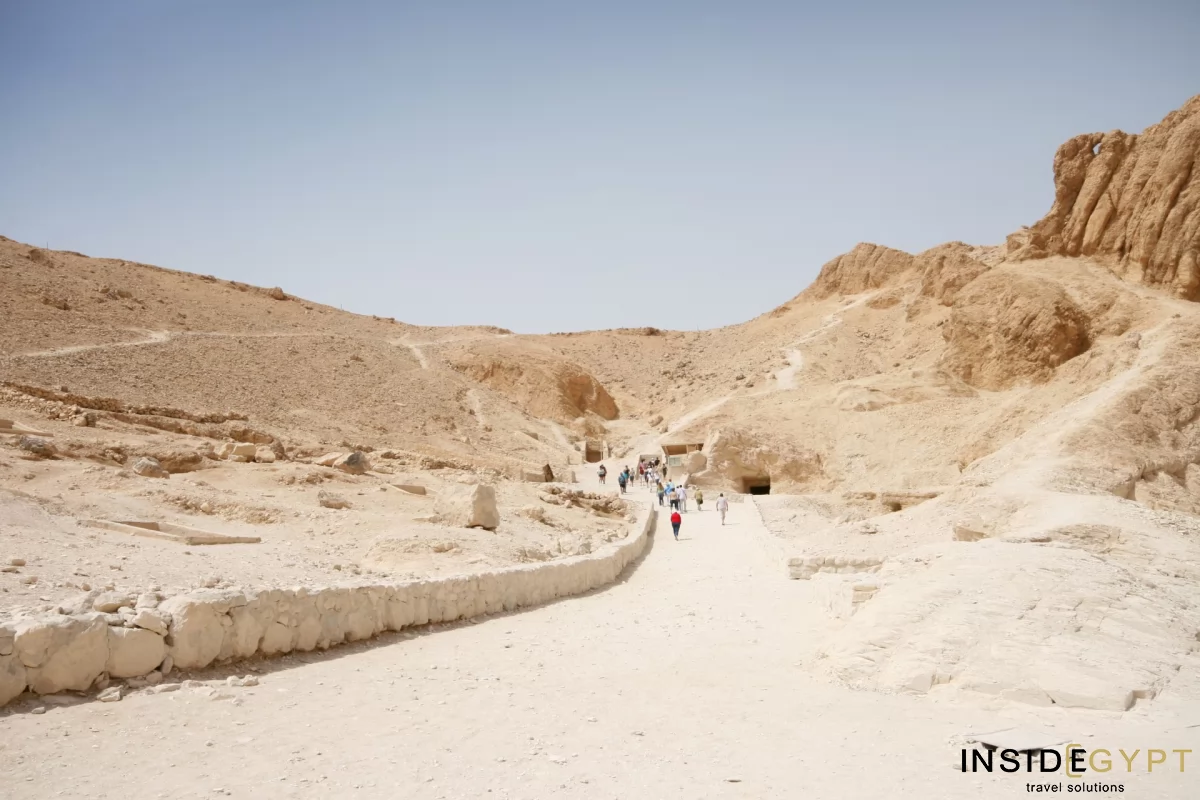
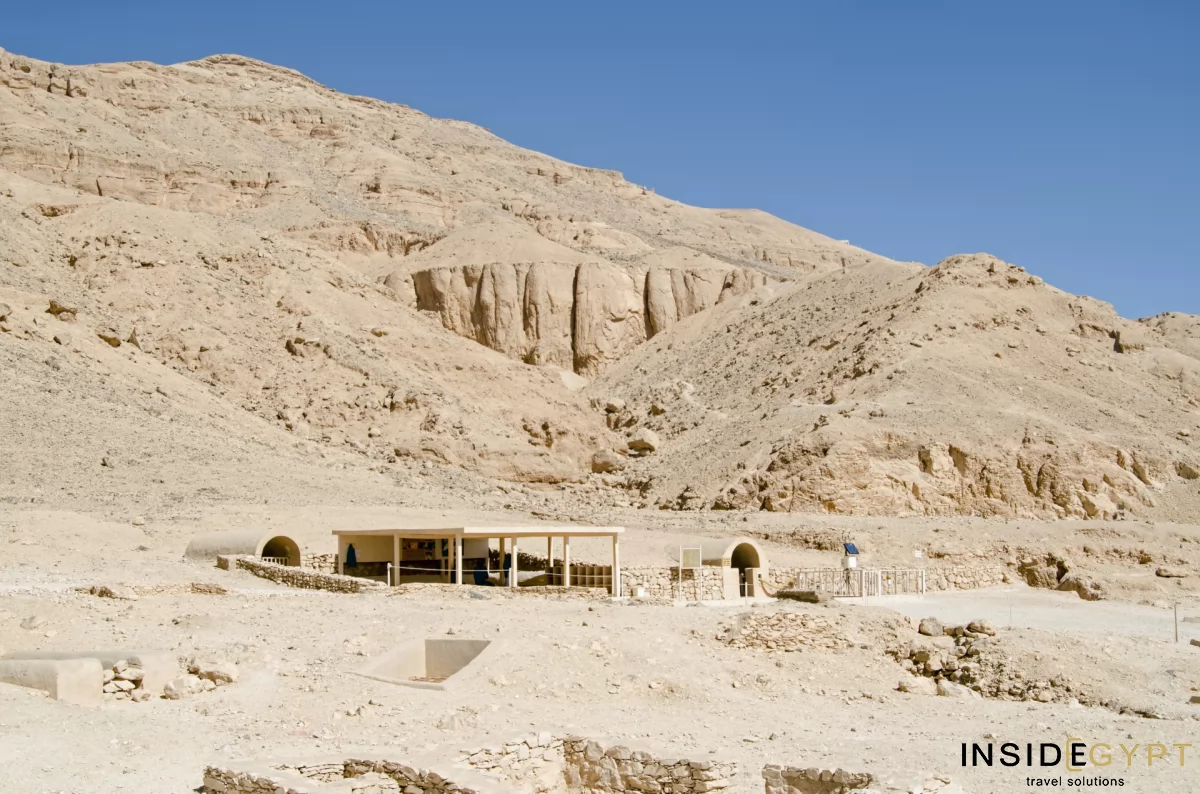
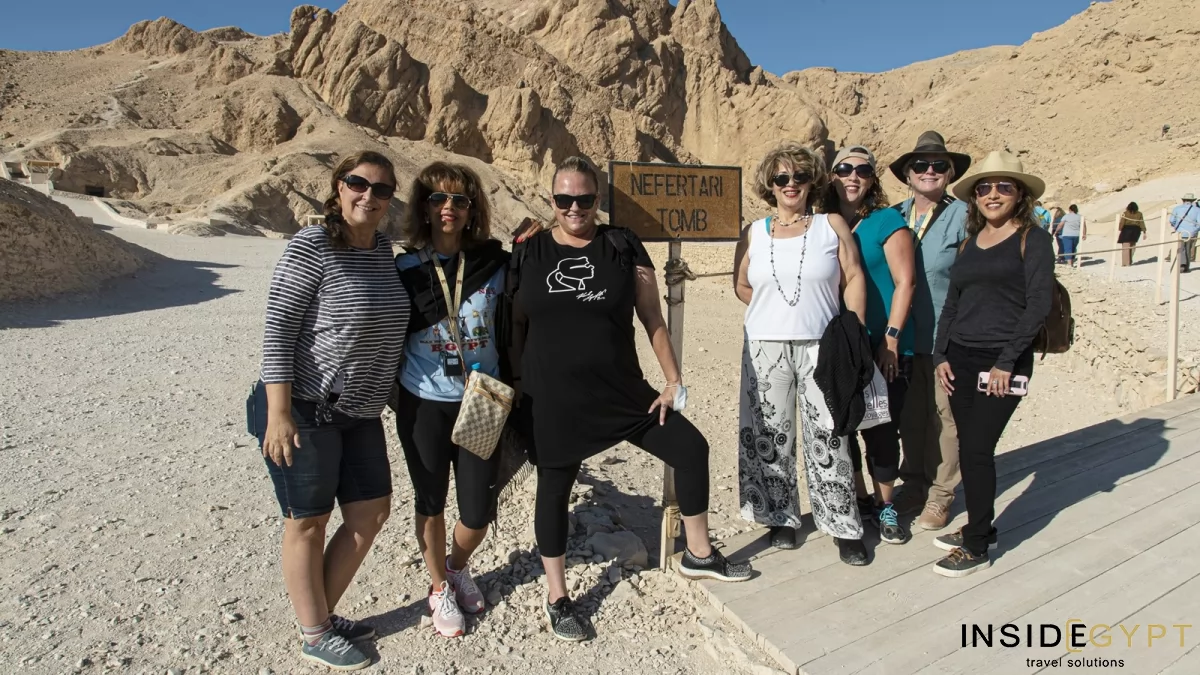
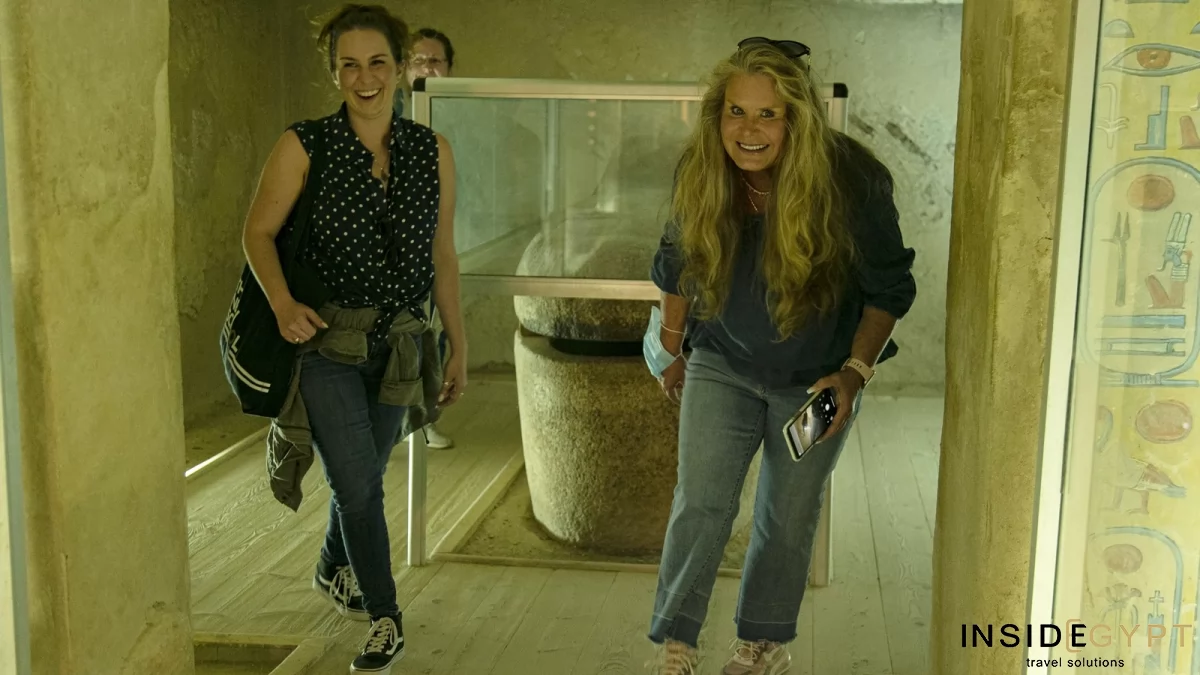
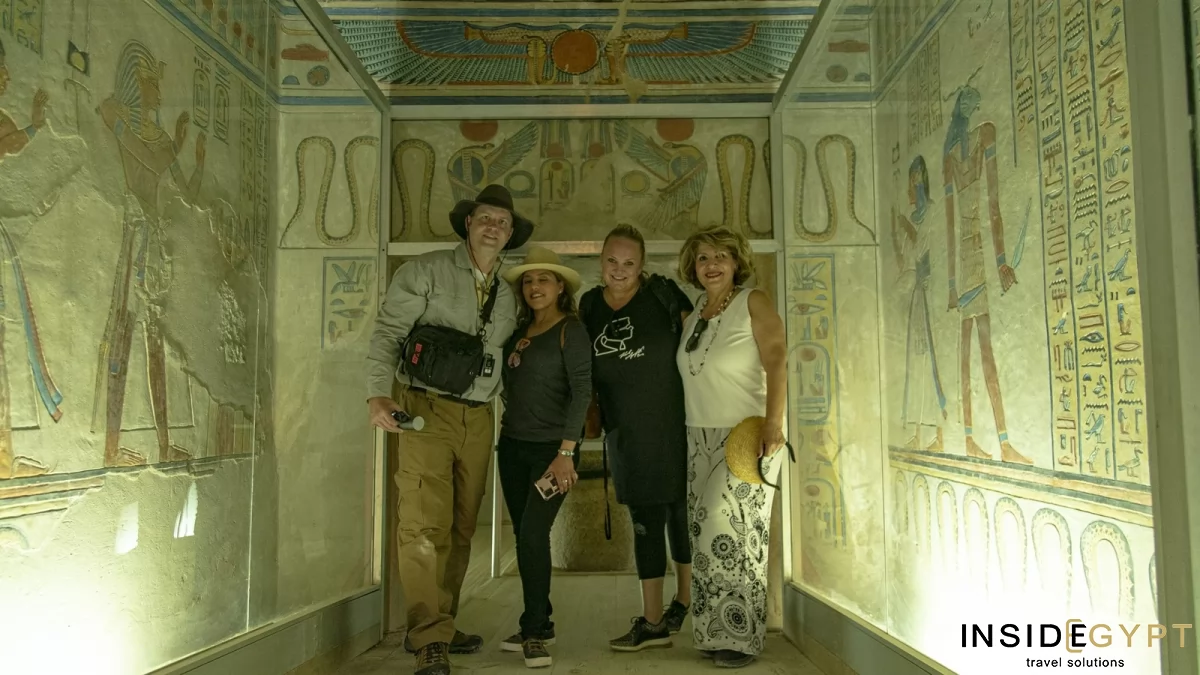
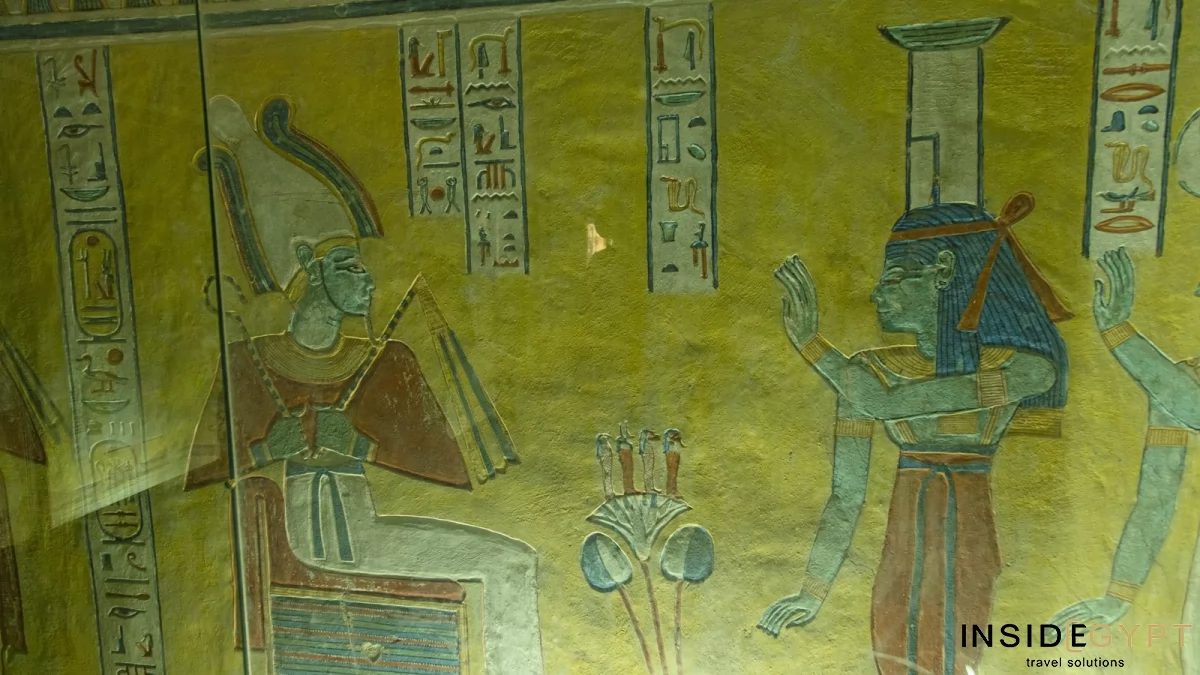
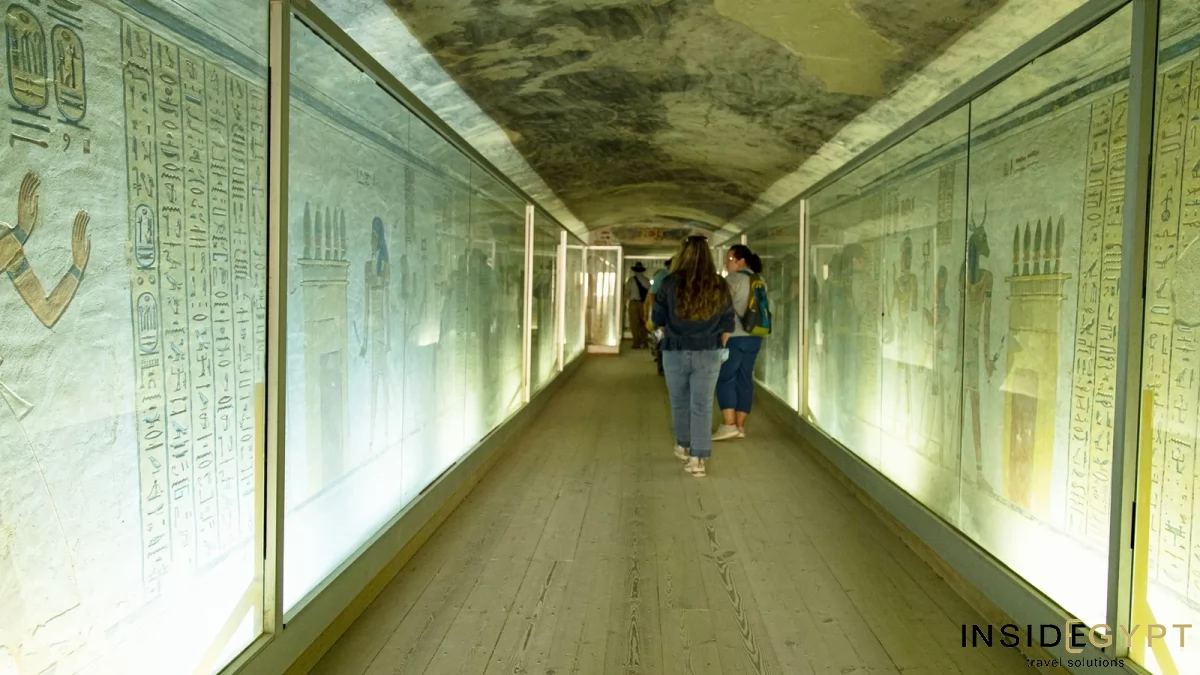
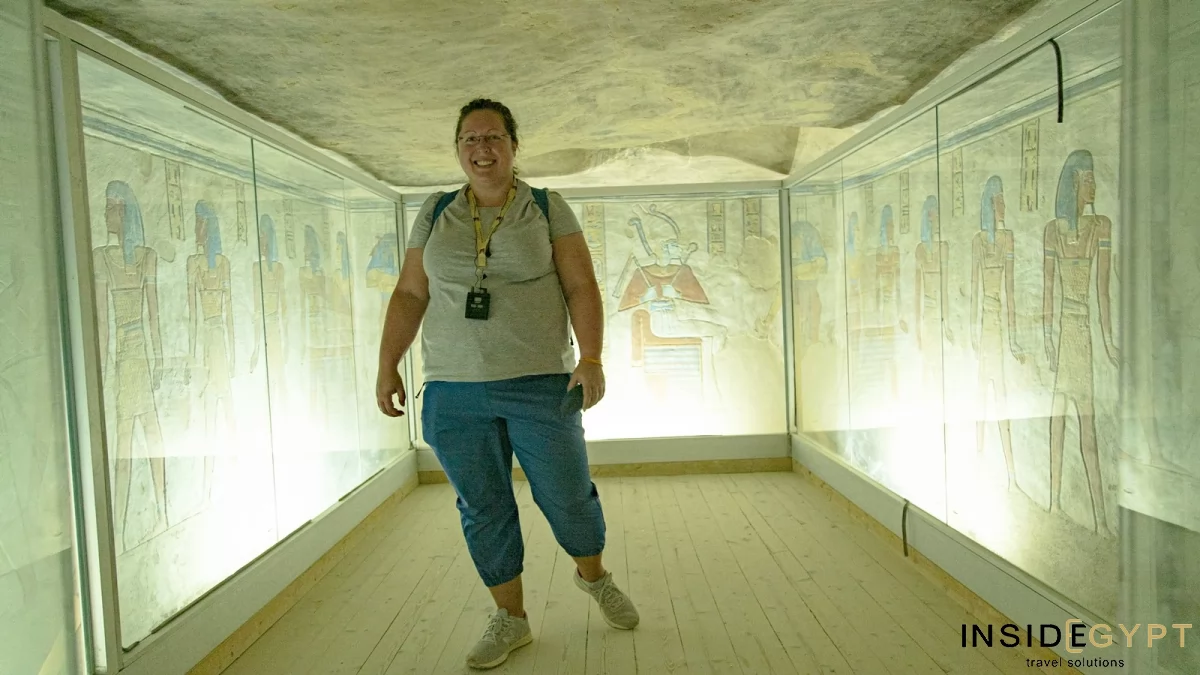
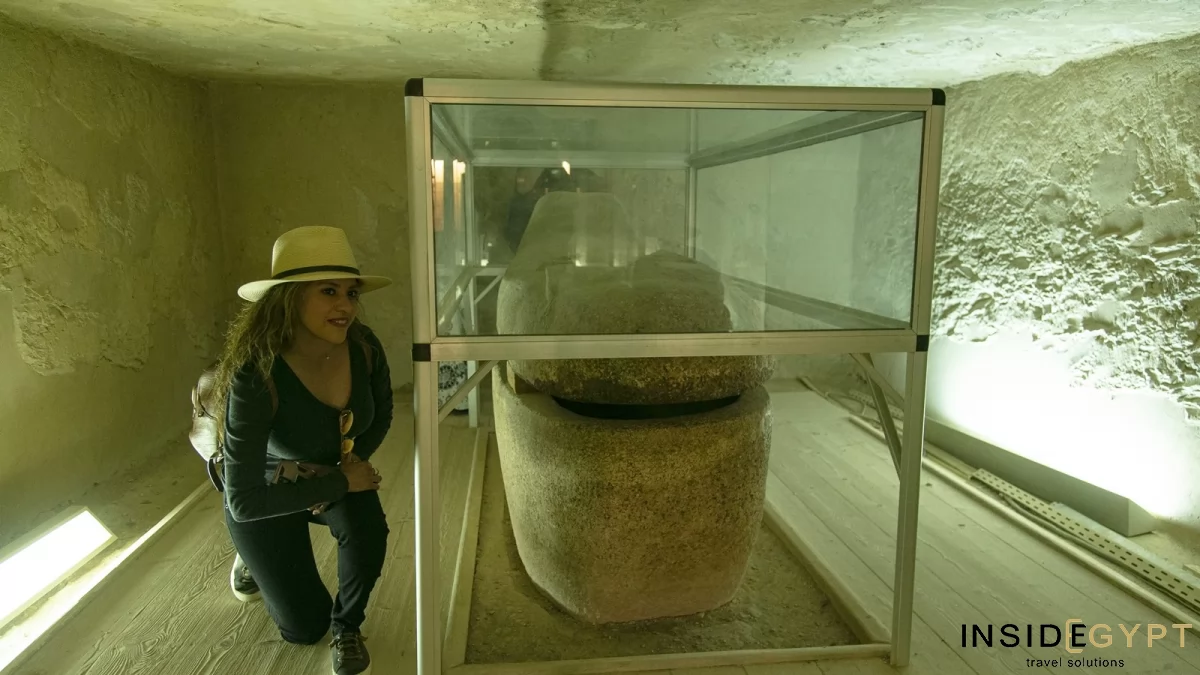
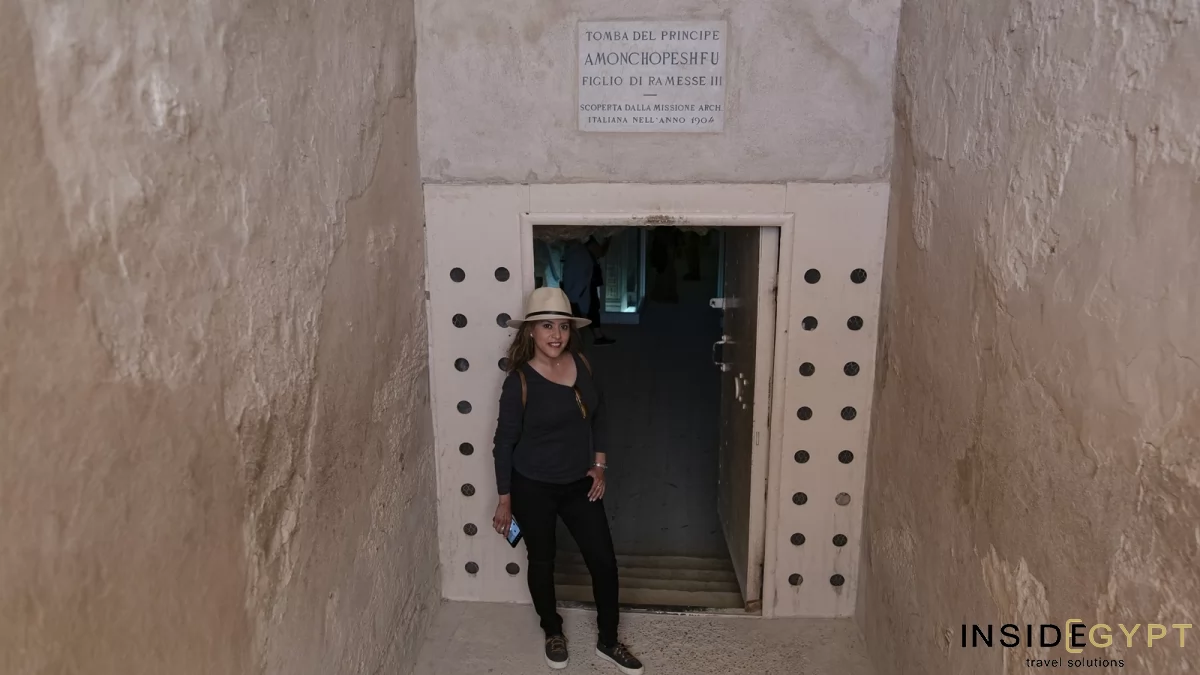
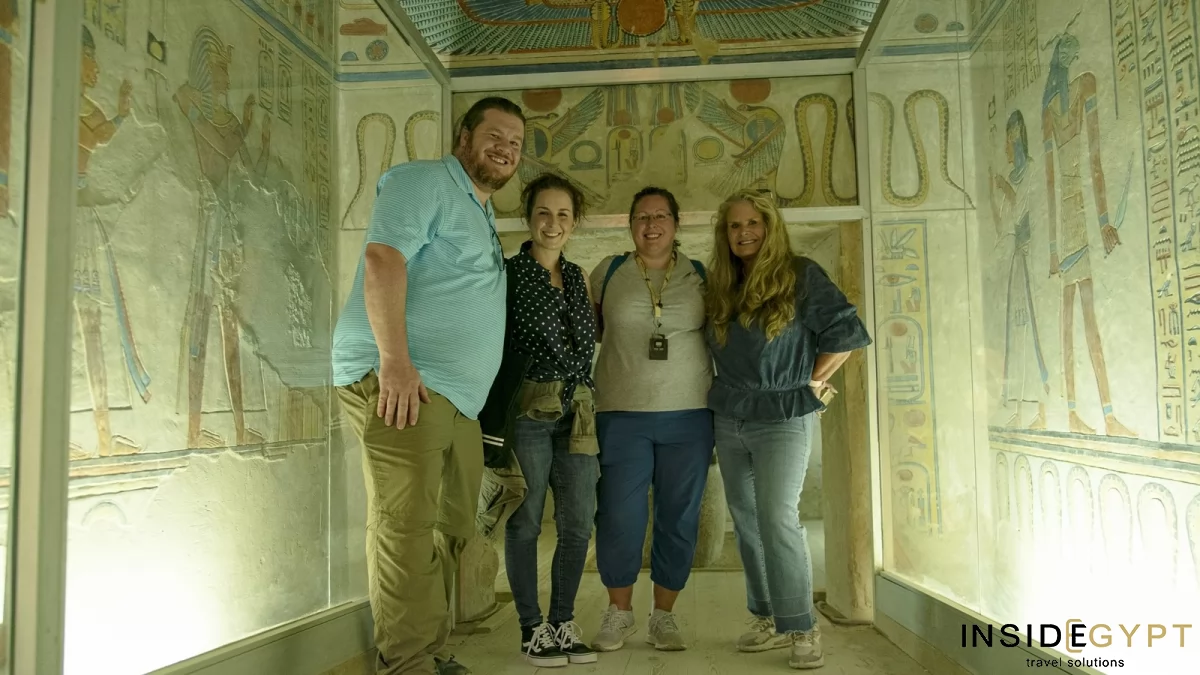
Discover Our Exclusive Egypt Tours
Tour Reviews
Valley of the Queens in Egypt FAQs
What is the history of this place?
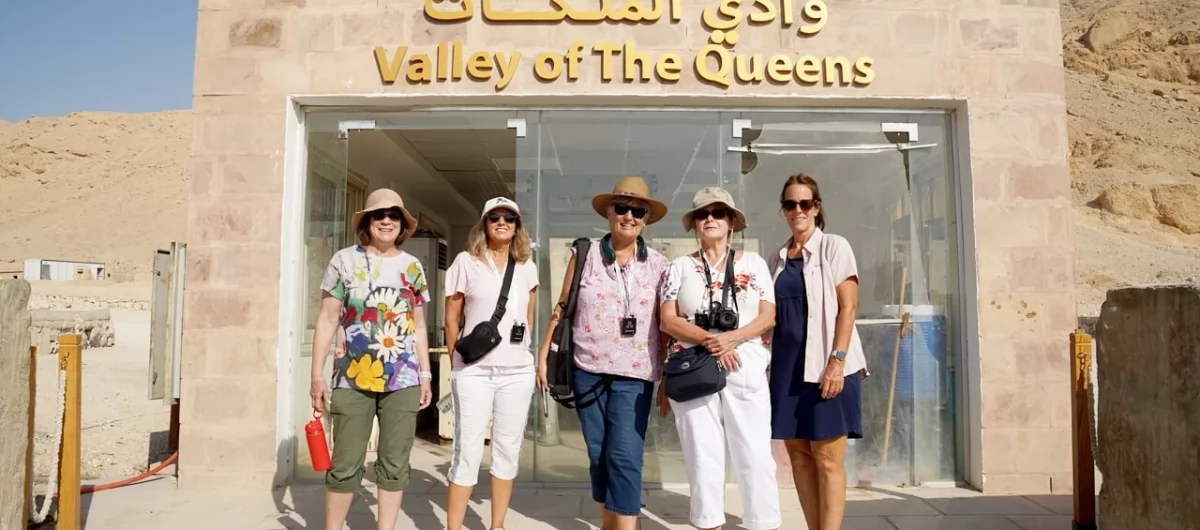
Egyptian queens chose a much more subtle location for their resting place than the inaccessible, rocky Valley of the Kings. It is a vast wadi (valley) that gently rises towards the Theban hills. With our guided Egypt Tomb Tours you can delve deeper into the fascinating history and architecture of these sites and gain a unique perspective on the lives of the powerful women who once ruled Egypt.
Contrary to its name, the Valley of the Queens has not always served as the resting place of Egyptian women. Originally, it served as a cemetery for royal children and people associated with the upbringing of princes and princesses. The earliest known tombs of the queens in this necropolis date back to the 14th century BC and 98 of the local hypogeas (rock tombs) were discovered at the beginning of the 20th century. Only half of the people buried in them have been identified to this date. Within the Valley of the Queens, tombs are numbered in the order in which they were discovered, and the tombs bear the QV symbolism, meaning Queens Valley.
The Hypogea in the Valley of the Queens in Egypt are very similar to each other, unlike the architecturally diverse tombs you'd see on our Valley of the Kings Tour. Along a straight axis, the few tomb rooms are arranged the same with a corridor, a vestibule, and a burial chamber, which may be surrounded by annexes.
One of the most interesting tombs in the valley is the tomb of the royal child - Khaemwaset (QV44), who was the son of Ramesses III. The decoration of the walls (painted reliefs at the entrance, polychromes deep in the tomb) mainly shows Ramses III and Khaemwaset surrounded by the gods. The prince is always shown with a curl of youth (a small curl that falls on the shoulder and is a symbol of young age). His father's companionship was necessary in the meetings with the gods, for the pharaoh was the mediator between the world of mortals and gods. Similar scenes can be seen in the tomb of another son of Ramesses III, Amonchopeshfu (QV55).
Queens' tombs are rare in Egypt. The most beautiful in the Valley of the Queens is the tomb of Nefretari, wife of Ramses II the Great. The ticket to the Valley of the Queens does not include this wonderfully decorated tomb but you can visit it for an extra charge. It is also worth seeing the tomb of Titi, one of the spouses of Ramesses III. The decoration of the walls shows the queen as a young girl and a mature woman at the time of worshiping the gods. Unfortunately, the frescoes have only been preserved in fragments, as the tomb was once used as a stable.
Explore the Valley of the Queens on our tailor-made tour! Book your Egypt group tour!
Which tours include a visit to the Valley of the Queens?
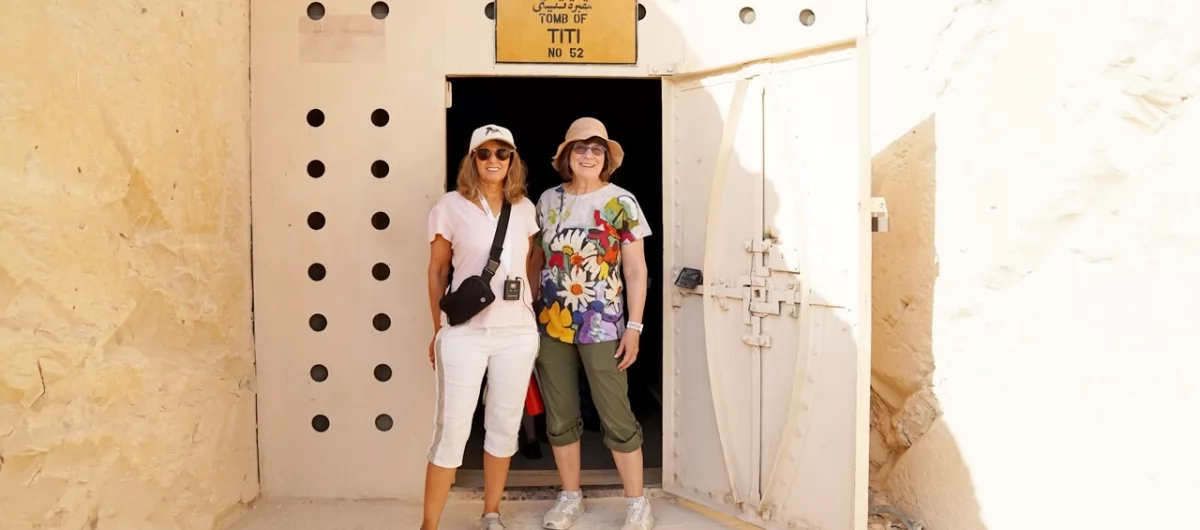
During the 14 Days in Egypt Tour, it is possible to add the Valley of the Queens tour as an optional trip.
Embark on a captivating journey through the ancient wonders and modern delights of Egypt on our exclusive 14-day tour. Prepare to be immersed in the land of Pharaohs and the majestic Nile, all while indulging in 5-star luxury accommodations and experiences that will leave you breathless.Your adventure begins with a once-in-a-lifetime opportunity: private access to the Great Pyramid and the enigmatic Great Sphinx in Giza. Stand in awe as you witness these iconic structures up close, unraveling their secrets and marveling at their grandeur. You'll have the privilege of visiting five Egyptian UNESCO World Heritage Sites, each one a treasure trove of history and culture. From the stunning temples of Luxor and Karnak to the mesmerizing Valley of the Kings, you'll step back in time and witness the legacy of ancient civilizations firsthand. Escape to the serene beauty of Fayoum Oasis, the gateway to the Eastern Sahara. Prepare to unwind and relax on a luxurious Nile cruise ship for seven days, floating along the lifeblood of Egypt.
As you cruise the legendary river, you'll be treated to panoramic views of timeless villages, ancient temples, and breathtaking sunsets that paint the sky with vibrant hues. No trip to Egypt would be complete without exploring Alexandria, the "pearl of the Mediterranean." Discover the fusion of ancient and modern as you stroll along the Corniche, see the majestic Qaitbay Citadel, and delve into the rich history of the Bibliotheca Alexandrina, a modern marvel paying homage to its ancient predecessor. Immerse yourself in the vibrant tapestry of local life when you visit the legendary Khan el-Khalili bazaar. Lose yourself in a maze of narrow streets adorned with colorful stalls, where you can haggle for unique souvenirs, savor traditional street food, and experience the warmth and hospitality of the Egyptian people.
Throughout our 10-Day Tour of Egypt, our clients can also visit the Valley of the Queens in Egypt and its main attractions as we offer a Valley of the Queens visit in the form of an optional tour.
Embark on an unforgettable 10-day journey through Egypt, where luxury and exploration blend seamlessly. This exclusive 5-star tour will take you on a captivating adventure across four cities, allowing you to immerse yourself in the country's rich history and awe-inspiring landmarks. No trip to Egypt is complete without marveling at the Pyramids of Giza and the enigmatic Great Sphinx. With our tour, you'll experience these iconic wonders in true royal style, enjoying a private visit that allows you to soak up their timeless magnificence without the crowds.
Indulge in the ultimate relaxation as you embark on a four-day Nile River cruise. Glide along the tranquil waters, witnessing the breathtaking beauty of the surrounding landscapes. Let the gentle current carry you past ancient temples, while you bask in the luxury of your floating oasis. Throughout your journey, you'll have the opportunity to visit four Egyptian UNESCO World Heritage Sites. From the awe-inspiring temples of Luxor and Karnak to the captivating Valley of the Kings, each site is a testament to Egypt's enduring legacy and will leave you in awe of its ancient civilization.
Immerse yourself in the vibrant local culture as you savor the flavors of authentic Egyptian cuisine. From aromatic spices to delectable street food, every bite will transport you to a world of culinary delight. And don't forget to indulge in a shopping spree at Khan el-Khalili, a bustling market where treasures from Egypt's past and present await your discovery.
What are the highlights of this location?
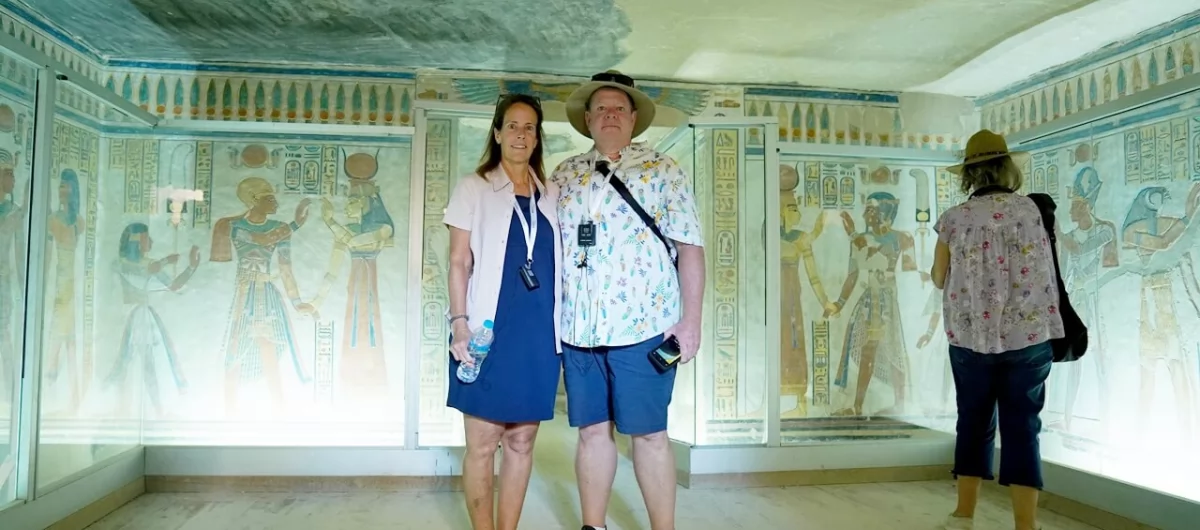
The Valley of the Queens in Egypt is located near the city of Luxor and is a fascinating archaeological site that is rich in historical significance, architectural wonders, and cultural treasures. It's also a UNESCO World Heritage Site. The Valley of the Queens served as the burial place for queens, princesses, and other members of the royal families during the New Kingdom period of ancient Egypt (approximately 1550–1070 BCE). Here are some of the key attractions and noteworthy features of the Valley of the Queens tour:
Tombs of the Queens
The Valley of the Queens contains several beautifully decorated tombs, each serving as the final resting place for a queen or a royal woman. One of the most famous tombs is the tomb of Queen Nefertari, the favorite wife of Pharaoh Ramses II. Queen Nefertari's tomb is renowned for its exquisite wall paintings, vibrant colors, and intricate details, making it one of the finest examples of ancient Egyptian funerary art.
Tomb of Queen Titi
The tomb of Queen Tyti, the wife of Ramses III, is known for its colorful and vivid wall paintings. The scenes depict various religious rituals, including the Opening of the Mouth ceremony, which was performed to ensure the deceased's eternal life.
Tomb of Queen Tuya (QV80)
Another notable tomb is that of Queen Tuya, who was the principal wife of Pharaoh Seti I. This tomb is distinguished by its well-preserved scenes depicting daily life, religious rituals, and mythological scenes. The artwork provides valuable insights into the beliefs and customs of ancient Egypt.
Tomb of Prince Amonchopeshfu (QV55)
Although not a queen, the tomb of Prince Amonchopeshfu, the son of Ramses III, is worth mentioning in the Valley of the Queens. This tomb is particularly interesting because it contains scenes depicting the prince's journey through the afterlife. The artwork provides insights into ancient Egyptian beliefs about the afterlife and the challenges the deceased had to overcome.
The tomb of Khaemwaset (QV44)
The tomb holds historical and cultural significance as a representation of the burial practices, religious beliefs, and social status of a royal child during the New Kingdom period. Its architectural design, religious scenes, astronomical ceiling, and burial goods all contribute to its uniqueness and provide valuable insights into ancient Egyptian culture and funerary customs.
Architectural Features
The tombs in the Valley of the Queens showcase impressive architectural features, such as long corridors, pillared halls, and elaborately decorated burial chambers. The ceilings and walls are adorned with colorful paintings, hieroglyphic inscriptions, and intricate reliefs, showcasing the artistic skills and craftsmanship of ancient Egyptian artisans.
Cultural Significance
The tour offers visitors a glimpse into the lives, beliefs, and burial practices of ancient Egyptian royalty, highlighting one of the key things to do in Luxor. Exploring the tombs in the Valley of the Queens provides a unique opportunity to understand the role of queens and royal women in ancient Egyptian society and their importance in the afterlife. Visiting the Valley of the Queens allows you to immerse yourself in the world of ancient Egypt and witness the remarkable artistic achievements of this civilization. The stunning artwork, architectural marvels, and historical significance of the tombs in the Valley of the Queens make it a must-visit destination for anyone interested in ancient history or archaeology.
Which Valley of the Queens tombs do you recommend visiting?
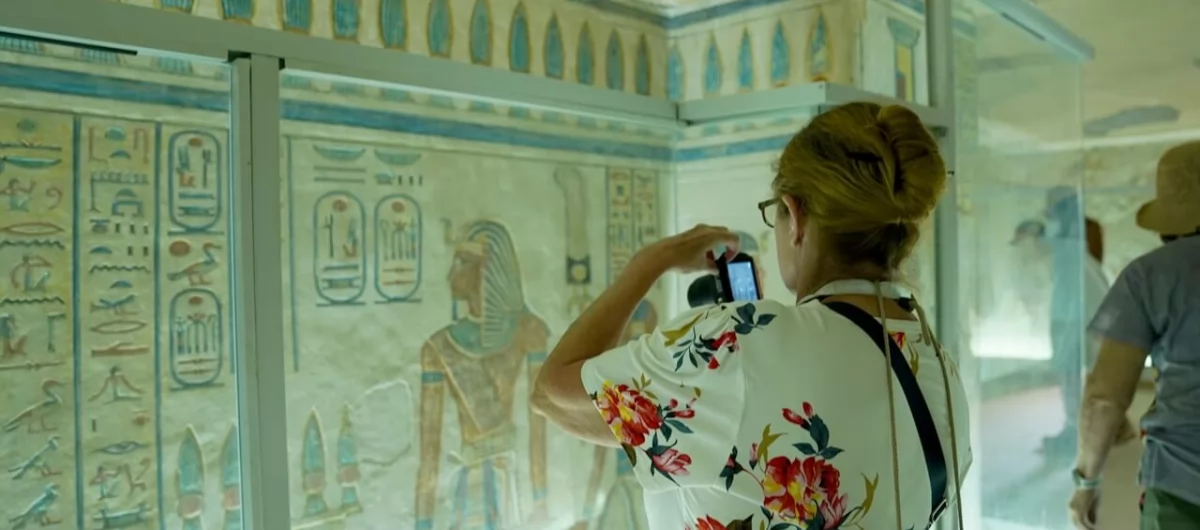
When visiting the Valley of the Queens in Egypt, there are several tombs that are highly recommended due to their historical and cultural importance, as well as their unique artwork. Here are some must-visit tombs the Valley of the Queens tour:
Queen Nefertari Tomb (QV66)
Queen Nefertari was the beloved wife of Pharaoh Ramesses II. Her tomb is considered one of the most exquisite and well-preserved in the Valley of the Queens. The tomb is known for its intricate and vibrant wall paintings that depict scenes from the Book of the Dead, religious rituals, and representations of Queen Nefertari with various deities. The detailed artwork, vivid colors, and the attention to detail make the Queen Nefertari tomb a true masterpiece that must be seen on the Valley of the Queens tour.
Tomb of Prince Amenherkhepshef (QV55)
Prince Amenherkhepshef was the son of Ramesses III. His tomb in the Valley of the Queens is notable for its well-preserved scenes depicting the prince with various gods and goddesses, as well as detailed texts from the Book of the Dead. The tomb also showcases scenes from the Judgment Hall of Osiris, where the deceased undergoes the judgment of his heart against the feather of Ma'at. It provides valuable insights into the Egyptian beliefs regarding the afterlife and the role of the deceased in the divine realm.
The tomb of Khaemwaset (QV44)
Khaemwaset was a royal child who lived during the 19th Dynasty of the New Kingdom period. His tomb consists of a simple rectangular burial chamber, with a sloping corridor leading to the entrance. The walls of the tomb are decorated with religious scenes and texts that reflect the funerary beliefs of the time. These scenes depict various deities, such as Osiris, Anubis, and Isis, as well as religious rituals and offerings being presented to the deceased. One unique feature of QV44 is the presence of a beautifully painted astronomical ceiling. This ceiling depicts the night sky with stars, constellations, and celestial bodies. This astronomical ceiling was intended to guide and protect the soul of Khaemwaset on its journey through the heavens. Additionally, the tomb contains inscriptions and reliefs that highlight the high status and lineage of Khaemwaset. The inscriptions mention his titles and roles, including "King's Son" and "Sem-Priest of Ptah," emphasizing his prestigious position within the religious and political hierarchy. The burial goods and funerary objects discovered in QV44 further reveal the cultural importance of the tomb. These include pottery vessels, shabti figurines, and funerary amulets.
Tomb of Queen Titi (Tomb QV52)
Queen Titi was the wife of Ramesses III. Although her tomb is relatively small compared to others in the Valley of the Queens, it is renowned for its colorful and well-preserved paintings. The walls depict scenes of the queen with different gods and goddesses, providing insights into the religious beliefs and rituals of the time. The artwork also showcases the queen's journey through the afterlife, highlighting her transformation and resurrection.
These tombs within the Valley of the Queens provide valuable insights into ancient Egyptian culture, religious beliefs, and burial practices. They showcase the artistic skills of the craftsmen of the time and offer a glimpse into the lives and afterlife beliefs of the royalty. Each tomb in the Valley of the Queens has its own unique features and artwork, making them stand out as exceptional examples of ancient Egyptian tomb decoration. See them for yourself on our Valley of the Queens tour.
Do we need to buy tickets?
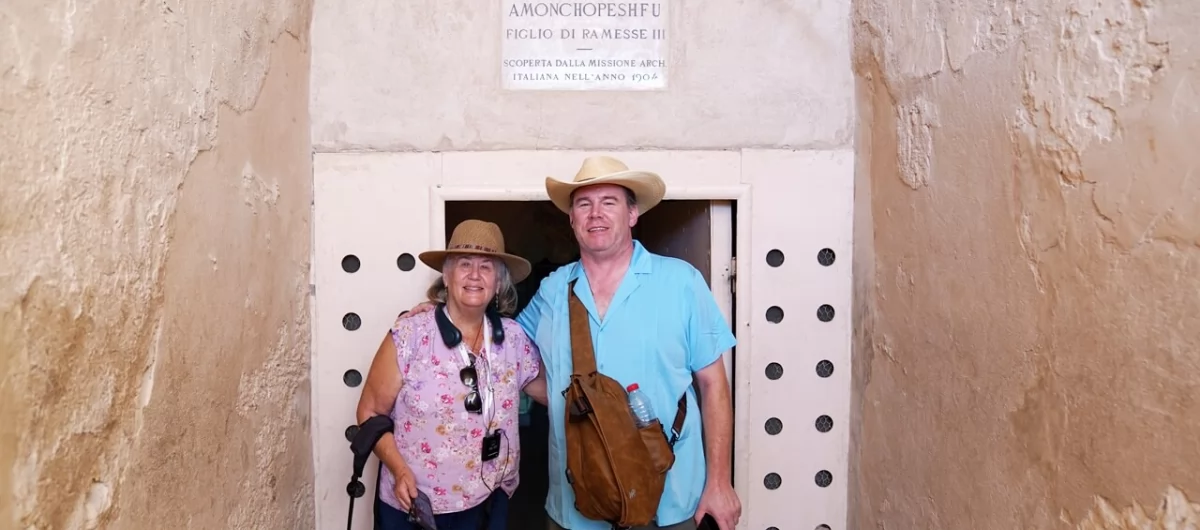
Inside Egypt provides comprehensive services to ensure a hassle-free experience for its guests. When you book an optional Valley of the Queens tour with Inside Egypt, the cost of the entrance tickets to the Valley of the Queens and Queen Nefertari tomb is already included in the tour price. This means that you do not need to purchase the entrance tickets separately for the Valley of the Queens. The current price for the entry ticket for visiting the Valley of the Queens for foreigners is EGP 100. With your entry fee, you will see three tombs on the Valley of the Queens site. They are: tomb of Titi, Khaemwaset and Amunherkhepshef. An entrance ticket to Queen Nefertari's tomb costs an additional 1,500 EGP.
Inside Egypt takes care of all the necessary arrangements and logistics for the Valley of the Queens tour, including obtaining the entrance tickets. We established partnerships and relationships with Luxor authorities, attractions, and suppliers to ensure a smooth and seamless experience for our clients.
By including the entrance tickets in the Valley of the Queens tour price, Inside Egypt eliminates the need for you to worry about purchasing tickets or dealing with any potential issues related to ticket availability or long queues at the ticket counter. It simplifies the process and allows you to focus on enjoying your visit to the Valley of the Queens and Queen Nefertari's tomb.
In addition to the entrance tickets, Inside Egypt also takes care of other aspects of this tour, such as transportation, knowledgeable guides, and any necessary permits or permissions required for visiting the attractions in Luxor. Our goal is to provide a comprehensive and enjoyable experience, allowing you to immerse yourself in the history and beauty of the Valley of the Queens without any unnecessary concerns or inconveniences.
How do we get to the Valley of the Queens?
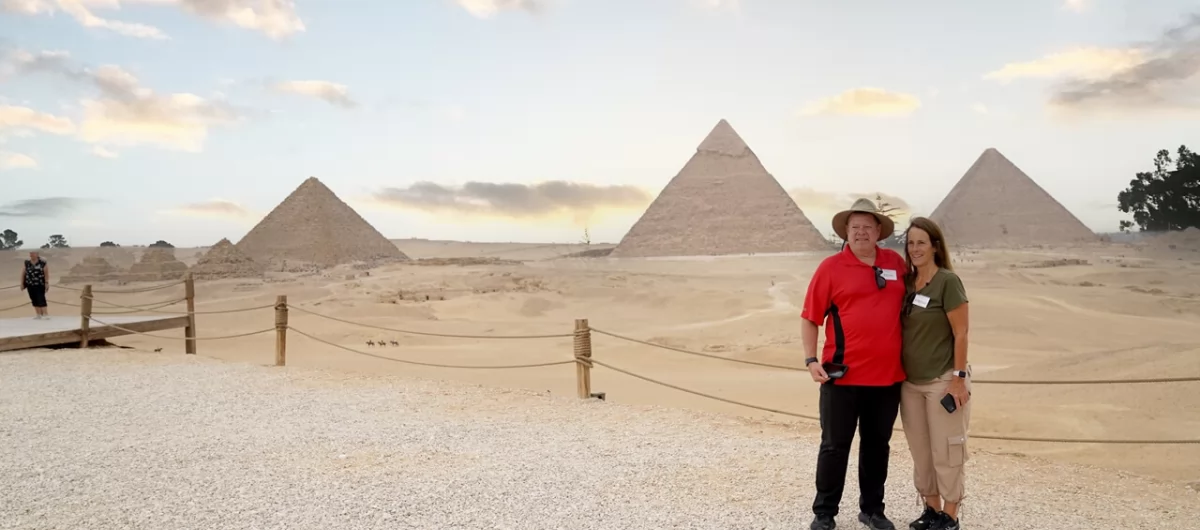
Our Valley of the Queens visit takes place during a Nile river cruise in Luxor. To visit the tombs in the Valley of the Queens, we will disembark from the cruise ship on the east bank of the Nile and cross the river via a motorboat to the west bank. On the west bank, we will be met by a comfortable and air-conditioned coaster with an experienced driver. The driver will transport us directly to the valley, dropping us off at the parking area situated in front of the entrance to the Valley of the Queens.
Once our tour of the Valley of the Queens in Luxor is complete, we will make our way back to the entrance to meet our transportation and driver. The coaster will then take us to the marina on the west bank of the Nile, where motorboats are available to ferry us back to the east bank. Upon crossing the Nile River, we will return to our cruise ship and start our journey along the Nile.
Inside Egypt takes care of the transportation for the Valley of the Queens tour, ensuring a hassle-free experience for its guests.
How long does this visit last?
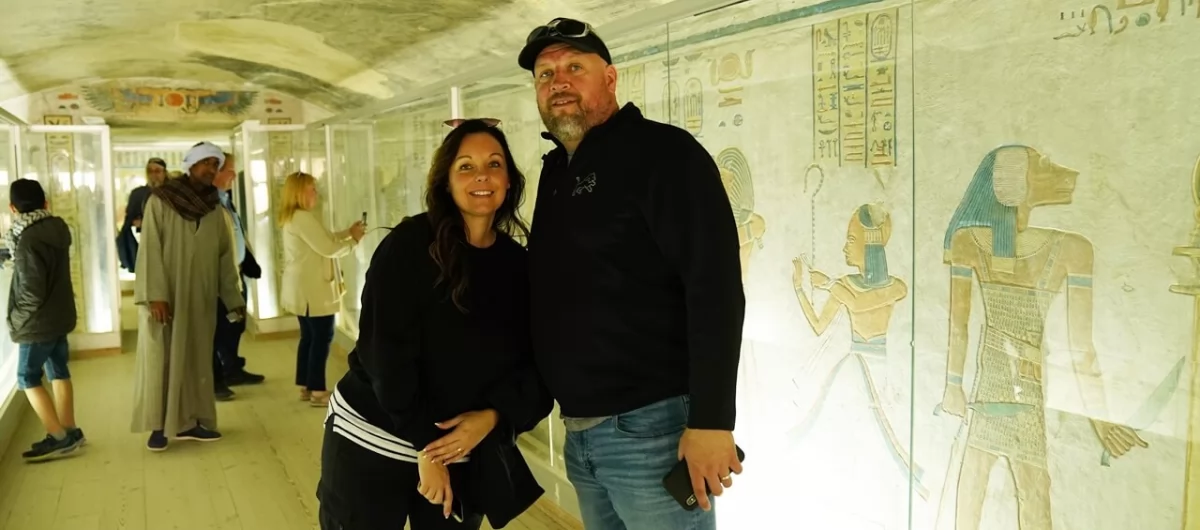
The Valley of the Queens in Egypt, located near the city of Luxor, is a UNESCO World Heritage Site and popular tourist destination known for its ancient tombs and historical significance. The duration of a visit to the Valley of the Queens can vary depending on several factors, including the level of interest in the site, the number of tombs one wishes to explore, and the time spent at other attractions in the area on the tour.
On average, visitors typically spend around 1 to 2 hours or longer exploring the Valley of the Queens. This time frame allows enough time to visit several tombs and appreciate the artwork and historical significance within them. However, some visitors may choose to spend more or less time visiting the Valley of the Queens, depending on their personal preferences and level of interest.
It's important to note that there may be time restrictions within the tombs themselves to preserve the delicate artwork and prevent overcrowding. Visitors to the Valley of the Queens are usually allowed a limited amount of time inside each tomb, typically around 5 to 10 minutes. These restrictions help ensure that the tombs are protected and that everyone has an opportunity to experience them during a Valley of the Queens tour.
Which clothes do you recommend wearing?
When visiting the Valley of the Queens in Egypt, it's important to consider both the weather conditions and cultural norms. The city of Luxor experiences hot and dry weather, especially during the summer months, so it's recommended to wear lightweight and breathable clothing. For both men and women, it's advisable to dress modestly out of respect for the local culture during this tour. Clothing should cover the shoulders, chest, and knees.
Loose-fitting lightweight pants, capris, or knee-length skirts are suitable options when visiting the Valley of the Queens. T-shirts or blouses that cover the shoulders are also viewed as appropriate clothing. Additionally, it's a good idea to carry a lightweight scarf or shawl to cover your shoulders in case you need extra coverage. Comfortable footwear is essential as you'll be doing a fair amount of walking and exploring on the Valley of the Queens tour. Opt for closed-toe shoes or sandals with good arch support, as the terrain can be uneven and rocky in ancient Thebes with its Necropolis. Avoid high heels or any footwear that may be uncomfortable or impractical for walking on uneven surfaces.
Lastly, remember to bring a hat, sunglasses, and sunscreen to protect yourself from the sun when visiting the Valley of the Queens. It's also a good idea to carry a small backpack or bag on the Valley of the Queens tour to store water, snacks, and any personal belongings you might need during your visit.
By dressing appropriately and comfortably, you'll be able to enjoy your visit to the Valley of the Queens and ancient Thebes with its Necropolis while respecting the local culture and staying comfortable in the hot Luxor weather conditions.
Which nearby monuments are worth seeing?
When visiting the Valley of the Queens in Luxor, Egypt, there are several nearby monuments and attractions that you might also consider exploring to enhance your Egypt experience. Here are some notable sites in Luxor, within a reasonable distance from the Valley of the Queens that you can visit as part of the Valley of the Queens tour:
Valley of the Kings
Located on the west bank of the Nile River, the Valley of the Kings is one of Egypt's most famous archaeological sites. It served as the burial place for many pharaohs of the New Kingdom period, including Tutankhamun and Ramesses II. The valley is known for its intricately decorated tombs and stunning wall paintings.
Deir el-Medina
Situated near the Valley of the Queens in Luxor, Deir el-Medina is an ancient village that housed the workers who built and decorated the royal tombs in the nearby valleys. It provides valuable insights into the daily life and activities of the craftsmen and artisans of ancient Egypt. Deir el-Medina includes well-preserved houses, workshops, and a temple dedicated to the goddess Hathor.
Temple of Hatshepsut
Located in the nearby Valley of the Kings complex, the Temple of Hatshepsut is an impressive mortuary temple dedicated to the female pharaoh Hatshepsut. It features a unique architectural design with terraces, colonnades, and elaborate reliefs. The temple offers breathtaking views of the surrounding desert and the Nile River and can be visited on this tour.
Colossi of Memnon
These gigantic twin statues of Pharaoh Amenhotep III are located on the west bank of the Nile, near the Valley of the Queens. The statues once guarded the entrance to Amenhotep III's mortuary temple, but today, only the statues remain. They stand about 18 meters tall and are a popular tourist attraction.
Medinet Habu
Situated on the west bank of the Nile, Medinet Habu is a vast temple complex dedicated to Ramesses III. It is renowned for its well-preserved reliefs, including battle scenes and religious rituals. The complex also includes a royal palace, a shrine, and several other structures.
Ramesseum
The Ramesseum is another impressive mortuary temple located on the west bank of the Nile. It was built by Ramesses II and is dedicated to the god Amun. Although partially ruined, the temple still showcases colossal statues and intricate reliefs.
These nearby monuments and attractions offer a diverse range of historical and archaeological experiences that complement the visit to the Valley of the Queens, providing a deeper understanding of ancient Egyptian culture, art, and history. Visit them with Inside Egypt on a Valley of the Queens tour.
Can I customize my own tour?
When visiting the Valley of the Queens in Egypt with Inside Egypt, there may be many other sights that you would like to see in Luxor. We are able to offer you a customized Valley of the Queens tour to make sure that you don't miss out. We can customize your tour package to give you complete flexibility with your itinerary to suit your individual requirements. As well as visiting the Valley of the Queens, we will also take you to the famous UNESCO World Heritage Site, the Valley of the Kings and Ancient Thebes with its Necropolis.
There's no need to do the same as everyone else when traveling with us at Inside Egypt. We will give you the best customized Valley of the Queens tour that you could imagine, making all your dreams come true!
